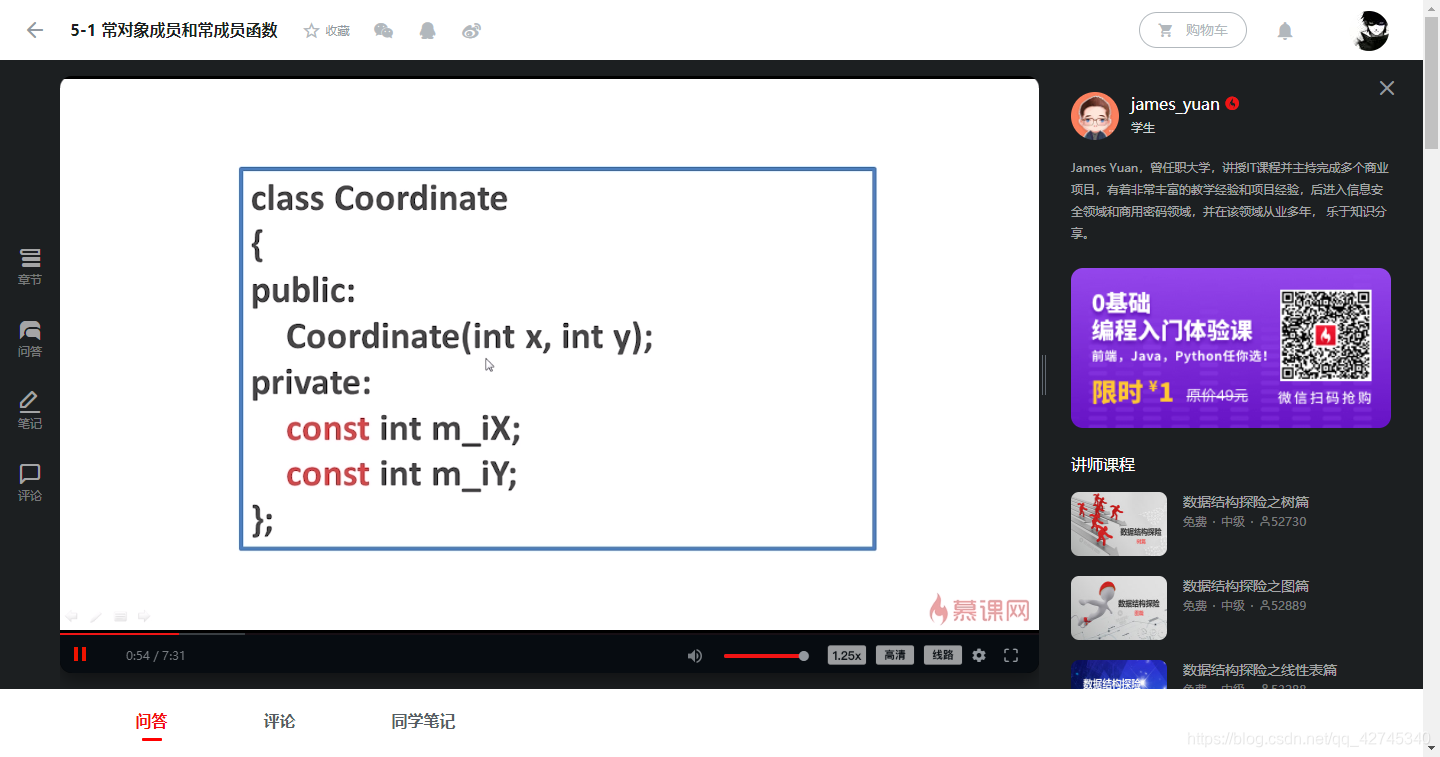5-1 常对象成员和常成员函数
例子:


常对象成员:



常成员函数:


上图:常成员函数中为什么不能改变数据成员的值?


上图:编译后this指针是用const指针修饰的,成了一个常指针,通过常指针改变指针指向的数据是不被允许的;

上图中:互为重载,但不推荐这样使用;

上图:调用的是不带const的函数;

5-2 常对象成员和常成员函数实践

Coordinate.h
#include<iostream>
using namespace std;
class Coordiante
{
public:
Coordiante(int x,int y);
~Coordiante();
void setX(int _x);//第一个参数(this指针)不加也行(默认的),之所以报错的原因是m_coora只读,而this指针可读可写
void setY(int _y);
int getX() const;//m_coora只读,而this指针可读可写,所以加const修饰就只读了
int getY() const;//const修饰之后成为常成员函数;set函数不能加const
private:
int m_iX;//只有类里的成员函数才能访问private的成员?
int m_iY;
};
Coordinate.cpp
#include<iostream>
#include "Coordinate.h"
using namespace std;
Coordiante::Coordiante(int x,int y):m_iX(x),m_iY(y)//可以用初始化列表也可以不用;
{
//m_iX=x;
//m_iY=y;
cout<<"Coordiante()"<<m_iX<<","<<m_iY<<endl;
}
Coordiante::~Coordiante()
{
cout<<"~Coordiante()"<<m_iX<<","<<m_iY<<endl;
}
void Coordiante::setX(int _x)
{
m_iX = _x;
}
int Coordiante::getX() const
{
return m_iX;
}
void Coordiante::setY(int _y)
{
m_iY = _y;
}
int Coordiante::getY() const
{
return m_iY;
}
Line.h
#include "Coordinate.h"
class Line
{
public:
Line(int x1,int y1,int x2,int y2);
~Line();
void setA(int x,int y);
void setB(int x,int y);
void printInfo();
void printInfo() const;
private:
const Coordiante m_coorA;//等价于Coordiante const m_coorA;
Coordiante m_coorB;
};
Line.cpp
#include "Line.h"
#include<iostream>
using namespace std;
Line::Line(int x1,int y1,int x2,int y2):m_coorA(x1,y1),m_coorB(x2,y2)
{
cout<<"Line()"<<endl;
}
Line::~Line()
{
cout<<"~Line()"<<endl;
}
void Line::setA(int x,int y)
{
//m_coorA.setX(x);
//m_coorA.setY(y);
}
void Line::setB(int x,int y)
{
m_coorB.setX(x);
m_coorB.setY(y);
}
void Line::printInfo()
{
cout<<"printInfo()"<<endl;
cout<<m_coorA.getX()<<","<<m_coorA.getY()<<endl;
cout<<m_coorB.getX()<<","<<m_coorB.getY()<<endl;
}
void Line::printInfo() const
{
cout<<"printInfo()const"<<endl;
cout<<m_coorA.getX()<<","<<m_coorA.getY()<<endl;
cout<<m_coorB.getX()<<","<<m_coorB.getY()<<endl;
}
demo.cpp
#include<iostream>
#include<stdlib.h>
//#include "Coordinate.h"//如果加了会出错:“class”类型重定义,只加line.h就行了(line.h已经引用了Coordinate.h)
#include "Line.h"
using namespace std;
int main(void)
{
Line l1(1,2,3,4);
l1.printInfo();
const Line l2(5,6,7,8);
l2.printInfo();
system("pause");
return 0;
}
运行结果
Coordiante()1,2
Coordiante()3,4
Line()
printInfo()
1,2
3,4
Coordiante()5,6
Coordiante()7,8
Line()
printInfo()const
5,6
7,8
请按任意键继续. . .
5-4 常指针与常引用
例子:




上图:常引用和常指针只有读权限,而getx()里的参数this是读写权限的,所以会出现错误,只能访问同样是常成员函数的printInfo;

上图:const在中间,指针不能指向其他对象,但指针指向对象的内容能变;说明此时是读写权限的指针,指向的对象可以读写,但不能指向其他位置;
pCoor->printInfo();指针是可读可写的,函数是可读的,所以可以(?)
5-5 练习题

普通对象可以调用常对象成员函数,常对象只能调用常成员函数;
5-6 单元巩固
定义一个坐标类,在栈上实例化坐标类常对象,并给出坐标(3,5),然后定义常引用、常指针,最后使用对象、引用、指针分别通过调用信息打印函数打印坐标信息。
#include <iostream>
using namespace std;
class Coordinate
{
public:
Coordinate(int x, int y)
{
// 设置X,Y的坐标
m_iX=x;
m_iY=y;
}
// 实现常成员函数
void printInfo() const
{
cout<<"("<<m_iX<<","<<m_iY<<")"<<endl;
}
public:
int m_iX;
int m_iY;
};
int main(void)
{
const Coordinate coor(3, 5);
// 创建常指针p
const Coordinate *p= &coor;
// 创建常引用c
const Coordinate &c=coor;
coor.printInfo();
p->printInfo();
c.printInfo();
return 0;
}
运行结果
(3,5)
(3,5)
(3,5)
